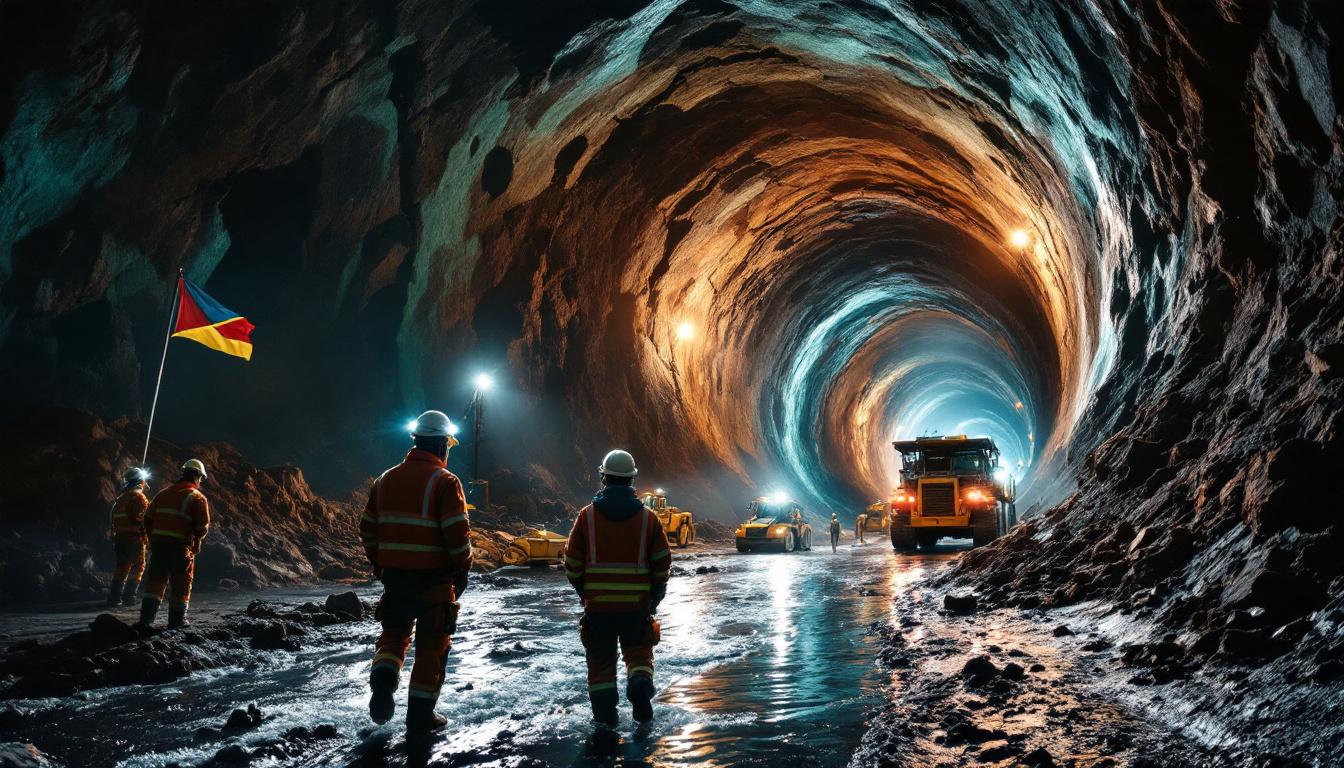Nippon Steel's 43% Profit Forecast Drop: Impact on US Steel Acquisition Plans
Nippon Steel, Japan's largest steelmaker, has announced a troubling financial projection that raises questions about its ambitious international expansion plans. The company forecasts a steep 43% decline in net profit for the fiscal year ending March 2026, adding complexity to its pending $15 billion acquisition of US Steel.
The Financial Reality Behind Nippon Steel's Profit Decline
Consecutive Years of Financial Deterioration
Nippon Steel's latest forecast projects net profit to fall to ¥200 billion ($1.4 billion) for the fiscal year ending March 2026. This represents a dramatic 43% decline from the previous year's results. More concerning for investors and analysts is that this follows another substantial drop—a 36% profit decline to ¥350.2 billion in the fiscal year ended March 2025.
These consecutive years of significant profit deterioration signal deepening challenges for the Japanese steel giant. The forecast assumes average steel prices of approximately ¥105,000 per ton and a yen-dollar exchange rate of ¥145/$1, highlighting the company's vulnerability to market price fluctuations and currency movements.
Root Causes of the Deteriorating Outlook
The primary driver behind Nippon Steel's profit decline is the severe supply-demand imbalance in the global steel market. As President Tadashi Imai explained:
"Excess production and increased exports from China amid their economic slowdown show no signs of easing, and this difficult environment is expected to persist throughout the current fiscal year."
Chinese steel production reached approximately 1.07 billion tons in 2024 (according to the World Steel Association), accounting for 57% of global output and creating a massive 42 million-ton surplus. Chinese exports surged 24% year-over-year in Q1 2025, flooding international markets and depressing iron ore price trends worldwide.
Additional pressures include:
- Rising carbon compliance costs: EU carbon border taxes adding €50–€90 per ton to imported steel
- Indirect effects of US tariffs: While Nippon Steel's direct exports to the US represent only about 3% of its revenue, the broader tariffs impact markets significantly
- Operational challenges: Higher energy costs and raw material volatility continuing to squeeze margins
The profit decline mirrors similar challenges facing other global steel producers. ArcelorMittal, for instance, reported a 19% profit decline in 2024 due to these same market pressures.
The $15 Billion US Steel Acquisition: Critical Juncture
Regulatory Timeline and Decision Process
Nippon Steel's proposed $15 billion acquisition of US Steel faces a critical decision period. Vice Chairman Takahiro Mori revealed specific dates for the regulatory process:
- The Committee on Foreign Investment in the United States (CFIUS) is expected to make its recommendation to President Trump by May 21, 2025
- President Trump's final decision is anticipated by June 5, 2025
This $15 billion acquisition would transform Nippon Steel into the world's third-largest steel producer, with a combined annual output of approximately 66 million tons. The CFIUS review is examining multiple national security factors under 8 CFR § 800.248, including critical materials supply chains and potential defense industrial base dependencies.
The deal's prospects improved when President Trump directed CFIUS to reexamine the proposal in March 2025, after it was previously rejected by the Biden administration. Nippon Steel maintains that the acquisition poses no risk to US national security.
Evolving from Business Decision to Political Issue
The acquisition attempt has transcended pure business considerations. As Vice Chairman Mori candidly acknowledged:
"The US Steel deal has evolved into a political issue beyond national security concerns."
This political dimension is evident in President Trump's March 2025 statement suggesting a potential compromise:
"I wouldn't mind if they [Nippon] took a minority stake. We need to keep our steel strong."
The United Steelworkers union has become a significant stakeholder in the process, insisting on job guarantees for approximately 12,000 employees as a condition for supporting any deal structure.
The acquisition has broader implications for US‑China trade war strategies and strategic partnership considerations. Japanese officials have emphasized the importance of maintaining strong economic ties with the US, especially in critical industries like steel manufacturing.
Potential Acquisition Scenarios and Strategies
Full Ownership vs. Minority Stake Options
Nippon Steel's leadership continues to emphasize that their primary objective is to acquire full ownership of US Steel. President Tadashi Imai has repeatedly stated that this remains their starting point in negotiations with US authorities.
However, the company is actively exploring alternative structures to secure regulatory approval. President Trump's suggestion about a minority stake has opened discussions about reduced ownership scenarios. Any restructuring to a minority position (below 25%) would trigger additional Department of Justice antitrust reviews and fundamentally alter the financial model underlying the acquisition.
A minority stake would require:
- Renegotiation of the original deal terms
- New valuation metrics for partial ownership
- Different governance structures and operational control mechanisms
- Potentially different financing arrangements
Financial Implications of Deal Outcomes
For investors, the financial impact of the acquisition's success or failure is substantial:
- If approved: Nippon Steel projects annual cost savings of approximately $1.2 billion from shared R&D and logistics efficiencies
- If rejected: According to a Nomura Securities note from April 2025, Nippon Steel would likely "pursue smaller, riskier deals in Southeast Asia" to achieve growth objectives
The current deal values US Steel at an EV/EBITDA multiple of 8.2x, compared to the industry median of 6.7x, reflecting the strategic premium Nippon Steel is willing to pay for US market access.
A BlackRock portfolio manager recently noted that "investors are pricing in a 60% probability of deal approval," indicating cautious optimism despite the regulatory hurdles.
Global Steel Industry Challenges
China's Dominating Influence
The global steel industry's challenges extend well beyond Nippon Steel's specific situation. China's steel production dynamics have created persistent structural imbalances in the market. The World Steel Association's May 2025 report offered a sobering assessment:
"The supply-demand imbalance will persist until at least 2027 without coordinated capacity cuts."
This oversupply situation has prompted defensive measures globally:
- EU safeguard measures in 2024 reduced Chinese shipments to Europe by 18%
- India implemented a 30% export duty on steel pellets, significantly altering ASEAN trade flows
- Section 232 tariffs in the US increased South Korean steel exports to the EU by 31% in 2024
Goldman Sachs analysis suggests that "every 10% drop in Chinese exports could boost global prices by $40/ton," highlighting the leverage China holds over market dynamics.
Decarbonization Imperatives
Beyond immediate market challenges, the steel industry faces mounting pressure to decarbonize. Nippon Steel has allocated ¥150 billion ($1.03 billion) for hydrogen-based reduction furnaces by 2030, demonstrating its commitment to long-term sustainability.
The carbon transition adds another layer of financial pressure on steelmakers, particularly as carbon border adjustment mechanisms like the EU's CBAM add €50–€90 per ton to imported steel that doesn't meet stringent environmental standards. However, companies are increasingly recognizing the decarbonization benefits for long-term competitiveness.
Investment Implications
Financial Indicators to Monitor
For investors assessing Nippon Steel, several key metrics warrant close attention:
- Dividend yield: Nippon Steel's forecasted 3.1% yield for 2026 trails competitor JFE Holdings' 4.5%
- Liquidity position: ¥1.2 trillion ($8.3 billion) cash reserves to weather acquisition delays or rejection
- Forex sensitivity: A 10% yen appreciation could erase approximately ¥45 billion ($310 million) from annual profits
The company's valuation fundamentals are increasingly tied to the acquisition outcome. The deal represents a critical strategic pivot that would provide direct access to the US market and significant growth opportunities. Without it, Nippon Steel would need to reconsider its international expansion strategy.
Risk Assessment Framework
Investors should build a comprehensive risk assessment framework considering:
- Political uncertainties: The ultimate decision rests with President Trump, introducing political variables beyond traditional regulatory considerations
- Global market volatility: Chinese production policies remain unpredictable and highly influential
- Currency exposure: Yen-dollar fluctuations directly impact profitability
- Carbon transition costs: Increasing regulatory pressure to decarbonize requiring substantial capital investments
Broader Industry Implications
Consolidation Trends in Global Steel
The attempted acquisition reflects accelerating industry consolidation trends in the global steel sector. Companies are seeking scale advantages and geographic diversification to weather market volatility and meet the capital requirements of decarbonization.
This deal's outcome will likely influence future cross-border acquisition attempts. A rejection based on national security grounds could chill international investment in US steel assets and potentially trigger similar protectionist responses in other markets.
US Steel Industry Future
The situation underscores the strategic importance of US steel production capacity. Regardless of the acquisition outcome, US Steel faces significant challenges in maintaining competitiveness against lower-cost international producers while meeting increasingly stringent environmental standards.
The Biden administration's previous rejection and the Trump administration's reconsideration highlight how steel policy transcends traditional partisan divisions in American politics, with both sides emphasizing the importance of domestic production capacity for national security and economic reasons.
FAQ: Nippon Steel's Profit Decline and US Steel Acquisition
What is causing Nippon Steel's profit to decline so dramatically?
Nippon Steel's profit decline stems from multiple factors, with Chinese steel market dynamics being the most significant. China's excess production capacity and increased exports amid domestic economic slowdown have created a widening global supply-demand gap. This imbalance shows no signs of improvement in the near term, with Chinese steel production reaching 1.07 billion tons in 2024 (57% of global output).
Additional factors include indirect impacts from US tariffs, rising energy and raw material costs, and increasing carbon compliance expenses, particularly in European markets where carbon border taxes add €50–€90 per ton to imported steel.
When will the US Steel acquisition decision be finalized?
According to Nippon Steel's Vice Chairman Takahiro Mori, the Committee on Foreign Investment in the United States (CFIUS) is expected to make its recommendation to President Trump by May 21, 2025. The final presidential decision is anticipated by June 5, 2025.
This timeline follows President Trump's March 2025 directive for CFIUS to reexamine the proposal, which had previously been rejected under the Biden administration.
Why is Nippon Steel pursuing US Steel despite its own financial challenges?
Despite short-term financial headwinds, Nippon Steel views the US Steel acquisition as a critical long-term strategic move for several reasons:
- Market access: Direct entry into the US market, bypassing trade barriers
- Geographic diversification: Reducing reliance on Asian markets dominated by Chinese influence
- Scale advantages: Becoming the world's third-largest steel producer with combined production of 66 million tons annually
- Technology synergies: Leveraging US Steel's expertise in certain specialized products
The company has substantial liquidity reserves (¥1.2 trillion or $8.3 billion) to finance the acquisition despite profit pressures. Nippon Steel projects annual cost savings of approximately $1.2 billion from shared R&D and logistics efficiencies if the deal proceeds.
What alternatives is Nippon Steel considering for the acquisition?
While maintaining that full ownership remains their primary goal, Nippon Steel is exploring alternative structures to secure regulatory approval. Following President Trump's suggestion that he "wouldn't mind" a minority stake arrangement, the company is considering:
- Reduced ownership percentages (potentially below 25%)
- Joint ventures with US-based partners
- Special governance arrangements to address national security concerns
- Enhanced commitments regarding US-based production and employment
Any restructuring would require significant changes to the original deal terms, including new valuation metrics, governance structures, and potentially different financing arrangements.
How would a failed acquisition impact Nippon Steel's strategy?
If the acquisition fails, Nippon Steel would need to substantially revise its international growth strategy. According to a Nomura Securities note from April 2025, the company would likely "pursue smaller, riskier deals in Southeast Asia" to achieve its growth objectives.
Alternative strategies might include:
- Focusing on organic capacity expansion in existing markets
- Targeting smaller acquisitions in regions with fewer regulatory barriers
- Accelerating investments in high-value specialty steel products
- Pursuing deeper operational efficiency improvements to maintain profitability
The company would continue facing challenges in directly accessing the US market, particularly as trade policies evolve.
Ready to Stay Ahead of the Next Mining Discovery?
Discover how ASX investors can capitalise on major mineral discoveries before the broader market with Discovery Alert's proprietary Discovery IQ model, delivering real-time notifications on significant announcements. Explore historical examples of exceptional investment outcomes by visiting Discovery Alert's dedicated discoveries page and position yourself for future opportunities.




